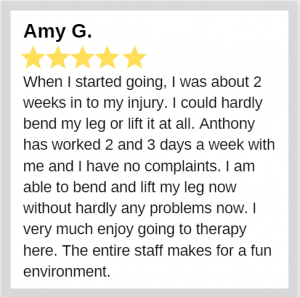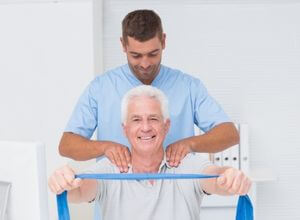A physical therapist with further education and training in orthopedics is known as an orthopedic physical therapist. Orthopedics is a field of medicine focusing on injuries to the bones, muscles, tendons, ligaments, and musculoskeletal system.
Orthopedic physical treatment, like regular physical therapy, can help you feel better and operate better. After orthopedic surgery, an orthopedic physical therapist can aid in your recovery and restoration of the operated area’s functionality.
Therapy does much more than make weak muscles stronger. You’ll also get the following in a clinic that specializes in orthopedic injuries:
- Control of either acute or ongoing pain
- Planning and execution of a home workout
- Having access to training tools to assist with performing daily tasks
- Exercising before going back to work
- Recovery of strength, mobility, and function
Orthopedic Physical Therapy: What Is It?

Therapy is a crucial step in the recovery from a wide range of illnesses and accidents, from head to toe: the better your long-term results, the more specialized the therapist in your area of damage. As a result, an orthopedic physical therapist will be more knowledgeable in treating injuries similar to those you have seen your favorite athletes experience during broadcast games. Yet, the spectrum of what they treat is vast. It includes everything from head injuries to the chronic or repetitive injuries people suffer at work to continuous pain from twisting their ankles at home.
The Workings of Orthopedic Physical Therapy
Orthopedic physical therapy treats dysfunctional bones, muscles, tendons, ligaments, or joints. Each component of the musculoskeletal system plays a specific role in enabling the human body to move and exert its entire range of strength. Pain and restricted motion occur when one or more of these parts malfunction.
Orthopedic physical therapy employs a variety of techniques to increase strength and flexibility in regions that have been damaged by sickness or accident. An orthopedic physical therapist could use heat or ice to ease pain or swelling or other techniques to help with movement or enhance circulation.
- Support equipment, such as a cane or walker
- To reduce pain, use ultrasound or electrical stimulation
- Exercise tools that increase strength
- Tools for evaluating circumstances and tracking progress
Physical exercise is the core component of the practice, even though technologies are frequently effective in assisting severely limited movement and reducing pain. Your orthopedic physical therapist may use assisted movement techniques until you are able to complete the exercises on your own.
Several patients even start physical therapy in the doctor’s office and continue their home exercises to strengthen and improve their mobility. During an orthopedic physical therapy session, certain exercises might be done, such as:
- Exercise with assistance to promote perfect form and increase flexibility
- Strengthening exercises for balance
- Workouts that increase muscle around injured joints, bones, or tissues
- Exercises for flexibility and stretching
- Exercises for endurance to maintain development
- A variety of mobility and function exercises to help the injured part regain its full range of motion and strength.
What Conditions Can Be Helped By An Orthopedic Physical Therapist?
Injuries

An orthopedic physical therapist can be helpful on numerous occasions and address a variety of ailments, including chronic injuries and injuries sustained in sports, auto accidents, and falls.
The best results for treating sports injuries come from combining professional orthopedic and sports physical therapy.
Usually, treatment aims to increase the range of motion, flexibility, and strength.
Rehabilitation Following a Serious Injury
When the body experiences trauma, such as a sprained ankle, herniated disk, etc., it is said to have an acute injury.
In this situation, an orthopedic physical therapist can aid in managing pain, regaining range of motion, strengthening, and educating patients on how to live with the limitations of the injury and prevent it in the future.
Rehab After Chronic Injury
Chronic injuries are yet another category of injury. During this time, your body sustains harm. It typically results from little, recurrent trauma to your tendons, bones, or joints.
Tennis elbow, carpal tunnel syndrome, shin splints, and other injuries are examples. An orthopedic physical therapist can provide pain and swelling management assistance and self-care instruction.
Health Issues
Many medical disorders are frequently treated with orthopedic physical therapy and advanced orthopedic physical therapy. Here are some of the most typical:
- ACL and meniscus tears, knee replacement, and knee discomfort all affect the knee.
- Ankle, foot, Achilles tendon sprains, and heel pain are all ailments of the feet.
- Hip problems include bursitis, discomfort, and limited motion.
- Clavicle fracture, frozen shoulder, and rotator cuff tear are all shoulder ailments.
- Spine disorders include scoliosis, a herniated disc, and lower back pain.
- Other: fractures, arthritis, Lyme disease, etc.
When Should You Go to An Orthopedic Physical Therapist
If you have any of the conditions listed above, consider visiting an orthopedic physical therapist. It would be preferable if you first knew the distinction between a physical therapist and a physiotherapist. Here’s how an orthopedic physical therapist may help.
Control pain. Pain can be decreased or eliminated with therapeutic exercises and other treatment approaches. Without the use of hazardous injections and addictive drugs, physical therapy does this.
Boost your mobility. An orthopedic physical therapist can assist with activities of daily living, including walking, ascending stairs, or participating in your preferred sports.
Build up muscle. Rapid loss in muscle strength might result from prolonged immobilization brought on by bone fractures, discomfort, or surgery. Orthopedic therapy can aid in strengthening muscles and regaining mobility.

Control the effects of aging. Senior individuals can manage their medical issues and recover from surgery with the aid of an orthopedic physical therapist.
Avoid invasive therapy. If the orthopedic physical therapy is successful, there is a much lower chance that you will require surgery.
Avoid falling. Orthopedic physical therapy helps avoid falls that cause additional injuries by enhancing strength and balance.
Enhance the standard of living. Your quality of life is improved by taking good care of your body with the assistance of an orthopedic physical therapist. You can resume the previous duties you were working on and lead your normal life.
The Orthopedic Physical Therapist: What to Expect
Starting any treatment can be frightening, and orthopedic physical therapy is no exception. Knowing what to anticipate from your sessions and treatment is quite helpful.
Before reaching out, verifying the therapist’s credentials is crucial because only therapists who have successfully finished orthopedic specialist programs may be regarded as subject-matter specialists.
Nonetheless, non-specialized physical therapists occasionally incorporate orthopedic physical therapy into their practices.
Your orthopedic physical therapist will thoroughly examine you as their first step. A personalized treatment plan will then be developed.
You can anticipate doing strength training and other challenging workouts.
An orthopedic physical therapist may also employ treadmills, ultrasounds, biofeedback, and other devices to aid your recovery.
A physical therapist specializing in orthopedics will recommend exercises to perform at home and show you how to do them appropriately.
You can anticipate receiving the following treatments during your visits:
Cold/hot therapy
Orthopedic physical therapists treat musculoskeletal pain and swelling with cryotherapy (cold therapy) and thermotherapy (heat therapy).
Exercises

Your orthopedic physical therapist will design an exercise program that improves balance, mobility, and strength.
Hydrotherapy
Exercise is a great time to use water therapy (in a pool or whirlpool), as it supports your body and lessens the impact on your joints.
Electrical Stimulation
The orthopedic physical therapist uses an e-stim device while treating you to stimulate the affected part of your body.
Transcutaneous Electrical Nerve Stimulation (TENS)
Using a device that provides electrical impulses to nerves, neuromuscular electrical stimulation (NMES) stimulates your muscles to contract and promotes blood flow, which aids in the healing of your muscles.
Neuromuscular Re-education
This therapy aids in restoring the voluntary muscle control that a patient may have lost due to pathology, injury, or atrophy.
Soft Tissue Manipulation
Your orthopedic physical therapist will most likely treat your muscles, ligaments, and fascia with hands-on methods. This could enhance circulation, lessen fluid retention or swelling around the injury, ease pain and stiffness, hasten the recovery of muscle sprains and strains, and help you regain range of motion.
Light or Laser Therapy
Your therapist may also employ low-level laser or light therapy during orthopedic care to improve muscle performance, lessen muscle fatigue, and facilitate muscle healing following injury.
How Long Does It Take To Recover?
The condition being treated frequently determines how long and what kind of orthopedic physical therapy you use. Goals achieved rather than therapy time is used to determine the effectiveness of all forms of physical therapy. While most soft tissue injuries recover in six to eight weeks, certain surgeries have a recovery period of at least a year. Orthopedic physical therapy helps patients regain strength without running the danger of reinjury by using the proper amount of activity.
For orthopedic physical therapy to be successful, patient involvement is essential. Your ability to appropriately execute exercises at work and home can significantly impact how quickly you recover. Occasionally a patient is dealing with a chronic illness that flares up, such as sciatica or arthritis. Exercises could be done forever at home for effective pain management in these kinds of situations.
If you don’t already have a doctor, we at Precision Sports Physical Therapy offer various rehabilitation options and effective orthopedic physical therapy. Reach out to us today!

